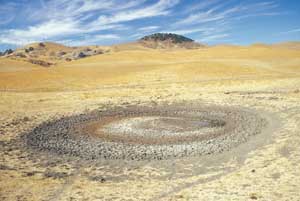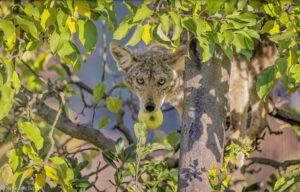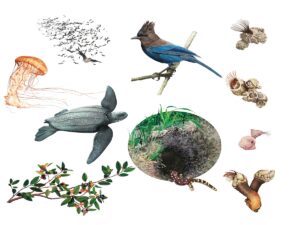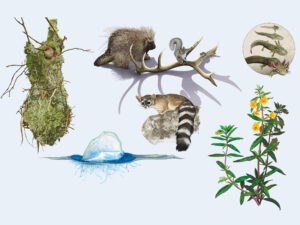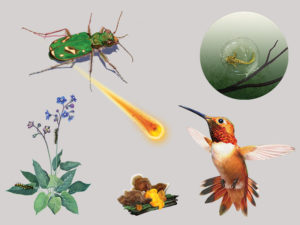The platonic ideal of a California pond is nestled in the hills near the high point of Briones Regional Park. On this summer’s day, the Sindicich Lagoons are soothing oases amid a canvas of yellow fields and bright sky. Thick shocks of grass, a stand of vibrant green sedges, even a copse of willows line the larger pond’s verdant shores.
- In summer, this pond at Brushy Peak Regional Preserve driescompletely. Native frogs and toads retreat into deep cracks in thesoil, where some moisture persists. Photo by Steven Bobzien.
American coots and resting mallards are ruffling the otherwise placid waters. A safe distance from shore, western pond turtles cling to half-submerged logs to warm their reptilian blood. Flame-red dragonflies slice the air in staccato bursts in search of insect prey. Near the water’s surface, turquoise damselflies have joined their needlelike bodies to mate. Together they hover over the water, he clasping her head to ward off other suitors, she placing eggs atop wisps of algae. Meanwhile, moist soil at the water’s edge has attracted mud-dauber wasps seeking nest material. One after another, they scrape together balls of soft soil and buzz out of sight. The whir of insect wings has pulled a western bluebird to the pond’s wire fence, in hopes of catching a few easy meals.
Things are no less hectic underwater. Backswimmers—black soybeans with legs—are windmilling their way through the clear water. Fly, mosquito, and beetle larvae wriggle by, dodging juvenile newts out to catch a meal. Among the sedges, garter snakes swim along in hopes of snaring an unwary California red-legged frog tadpole.
In the often-arid hills of the inland Coast Ranges, ponds are magnets for animals large and small throughout the year. In spring, gumball-size Pacific tree frogs converge to lay masses of eggs. On warm summer nights, raccoons feel about with black-gloved paws for late-hatching tadpoles. During Indian summers, ground squirrels, deer, and cattle stop by seeking water and greener forage, with predators such as cougar and coyote close behind. As the weather turns cold, shorebirds migrating from their arctic nesting areas stop to rest and refuel with a pond snail or two.
Perhaps the most spectacular event at many California ponds is the annual pilgrimage of breeding California newts. The first big rains of winter propel these retiring creatures from the uplands toward local pools in a poky stampede. Though slow of foot and tender of flesh, most of these hand-size amphibians will survive the journey, which can be as long as a mile. Their defense is the weapon of choice for the meek: poison. California newts carry tetrodotoxin, one of the most potent neurotoxins known; a few micrograms are enough to fell a human. It’s the same substance that makes pufferfish sushi an occasionally fatal thrill.

- The California newt got the worst of this exchange, but the gartersnake likely fared little better, as newts carry a potent neurotoxin.Photo by Joe DiDonato.
Steve Bobzien, a biologist with the East Bay Regional Park District, has watched garter snakes regret a newt entree on several occasions. “I’ve watched them go into paralytic convulsions,” he says. “They spat up the newt and wrapped themselves in knots.” Some of these snakes appeared to recover within a half-hour; others, not so lucky, died. Then there are reports of snakes ingesting newts with no problem. Scientists aren’t sure whether there is variation in individual newts’ toxicity, or whether it fluctuates with diet.
While newts will also breed in streams, California tiger salamanders primarily use ponds for breeding. The striking yellow-and-black adults spend all but one or two months of the year farther upland, deep in the burrows of ground squirrels or other rodents. They may trek up to two miles to a breeding pond after the autumn rains have begun. A female will lay clumps of up to three transparent teardrop-shaped eggs, each about the size of a pea, on floating vegetation; by the time she’s done, she’ll have added up to 1,400 potential progeny to the pond. At hatching, larvae are no larger than a grain of rice. But within a few months, they’ll reach lengths of five inches or more, becoming formidable aquatic predators able to subdue water scorpions.
Despite their importance to many native species, most East Bay ponds aren’t themselves natural. Of the approximately 275 ponds on East Bay Regional Park District lands, at least 268 are manmade. Virtually all are stock ponds, created by ranchers who dammed creeks, deepened natural hollows, or impounded water from upland seeps. Their industry created a whole new class of habitat. Now, some of these ponds are little more than recurring puddles, while others aspire to lake status, ringed with cattails and crowded with flocks of swimming ducks.
The proliferation of ponds has been instrumental in keeping native amphibian populations afloat. Since the Gold Rush era, mining, agriculture, and development have destroyed many existing ponds and pools in the Sierra foothills, Central Valley, and San Francisco Bay Area. Today, says Bobzien, “the stock ponds may have actually augmented and increased populations of threatened amphibians to some degree.”
A case in point is the California red-legged frog. A jaunty reddish-pink with blotchy brown spots, this threatened species has lost more than 70 percent of its original habitat. Gold Rush miners filled its foothill pools with silt, while housing and highways have replaced much of the frog’s lowland habitat. However, thanks to the stock ponds, populations in the Park District stand at a stable 700 or so adult frogs, based on district radio-tracking studies.
These studies indicate that in very dry months, red-legged frog adults may migrate upland to stay cool in rodent burrows. Bobzien remembers tracking one frog to a burrow with unusual entrance decor—the freshly shed skins of rattlesnakes. “It may not have been in the same part of the burrow as the snakes; all I know is that there was a live California red-legged frog down there,” he says.
The presence of protected amphibians like the California red-legged frog and tiger salamander presents the Park District with a continuing challenge: to ensure that these species are able to flourish, while maintaining diverse and healthy populations of other native species.
The effect of grazing on California grasslands has long been controversial, but until recently, little hard data has been available to measure its impact on aquatic ecosystems. Because cattle graze on more than 50,000 acres of district property, there was some concern that they could be damaging pond ecosystems.
This led to a decade of study of the effects of cattle on amphibians in the district. The results, published just this spring, not only have given biologists new insights into the secretive lives of pond dwellers, but underscore how grazing has, in some places, helped shape and maintain the landscape to benefit native amphibians.
In the study, biologists compared amphibian populations at ponds visited by cattle with fenced ponds where cattle were excluded. They found that fenced ponds tended to lose amphibian species such as California tiger salamanders and red-legged frogs. Left unmolested, the European weeds that now dominate state grasslands grow into an impenetrable, weedy thatch. “Imagine if you were a little salamander and you had to get through that thatch to get to the pond to breed,” says Joe DiDonato, the district’s stewardship manager. “Grazing has been our main tool to control all of those nonnative grasses.”
Ecologically speaking, the importance of grazers in local grasslands makes perfect sense. Though not native to California, cattle do a passable job of filling the hoofprints of absent ungulates such as elk and pronghorn, and before them, the giant camels, bison, and zebra that roamed North America during the Pleistocene.
Modern amphibians are not only adapted to pond disturbance by grazers—some, like the tiger salamander, depend on it. “In my public talks, I like to show a slide of a mud hole where cattle have grazed the vegetation down to the dirt,” DiDonato says. “People look at that and go, ‘Oh my God, the cows just destroyed this pond!’ Then I say, ‘This pond has the highest population of California tiger salamanders of any of the ponds we’ve surveyed.’ And their jaws just drop.”
What does a murky puddle offer that a pristine, limpid, reed-ringed pool doesn’t? Safety from predators, of course. Ponds up and down California and elsewhere harbor several voracious predatory insects, including giant water bugs. With a body the length of your big toe and a poisonous bite to boot, water bugs lie in wait for prey amid the green tangles of aquatic plants. When they spot a likely target paddling by, they pounce. Like spiders, water bugs inject a poison that first paralyzes victims, then liquefies their tissues, leaving the bugs free to suck their meals at leisure. The researchers found that undisturbed ponds with lots of water bugs had virtually no tiger salamanders. The clear water makes larval salamanders proverbial sitting ducks.
Cattle graze down plants along pond edges and stir up pond sediment, leaving turbid waters that keep larval salamanders hidden from predatory insects and other sight hunters such as herons and garter snakes. The absence of shoreline vegetation also deprives the bugs of their favorite hiding places. Murk doesn’t hinder young salamanders, however— they seem to eat by feel, vacuuming up larval backswimmers, water boatmen, or anything else they can swallow. In fact, says Bobzien, when “we went to a pond with a high density of California tiger salamanders, they were the overwhelming vertebrate species in the pond. Turbidity may prohibit other species from occurring; it ecologically releases tiger salamanders to be more successful, because there’s a lot less competition.”
The predatory insects, garter snakes, and herons are also native species, so to ensure good homes for all pond creatures, district managers maintain a wide variety of ponds, from the larger Sindicich Lagoon—clear, deep, and fenced—to tiny puddles the color of milk chocolate.
Curiously, a dozen ponds surveyed by district staff were colonized by giant water bugs in some years and tiger salamanders in others. Two factors, say biologists, likely affect the balance: the permanence of the pond, and the size of the predator in power. Year-round ponds appear to favor predatory insect populations, since many of these bugs can overwinter in the relatively temperate water. Tiger salamanders that hatch in these ponds are easily overpowered by hunting water bugs. But the insects don’t always have the upper hand. They abandon seasonal ponds in summer, when the pools dry up. Later in the winter, if these wandering bugs enter a pond with established tiger salamander larvae, they’re done for—by that point, the salamanders are more than large enough to swallow smaller water bugs and other insects.
But don’t count on finding tiger salamanders in particular ponds every year. Recent research suggests they may come down from the hills to breed only two to three times in an 11-year life-span. “We’ve documented tiger salamanders breeding in 75 ponds, but from one season to the next, they tend to use less than half of the available ponds,” Bobzien says. That poses a problem for salamander protection, since a pond surveyed for development in an off year can erroneously be declared salamander free. “All of a sudden you’ve lost another breeding location for a population that’s already in dire straits,” Bobzien says.
Given the many rare species sheltered in district ponds, unauthorized collecting is always a problem, but pet releases—mostly of red-eared sliders, eastern box turtles, and bullfrogs—pose an even larger danger. “People don’t want to hang on to Greenie anymore, so they release him into the park,” DiDonato says. “They don’t realize that they could be introducing a disease, a predator, something that might affect native populations.” The threat is very real: Bullfrogs, carp, and bluegill can kill off all of a pond’s red-legged frogs or tiger salamanders in a single season.
Once settled, nonnatives can be a chore to eradicate. Fish and turtles are the easiest to eliminate: Biologists simply remove the water. The fish asphyxiate and the turtles are suddenly a snap to catch. (New district ponds built as mitigation for development have drainage systems for this very reason.) But it’s virtually impossible to capture every bullfrog. Instead, district personnel will drain an infested pond and then bulldoze in a foot-deep layer of soil, entombing any lingering adults beneath a soil cap.
Though many are imperiled, native amphibians can be pretty tough themselves. “California red-legged frogs, western toads, and Pacific tree frogs have pretty wide tolerances of extreme temperatures and environmental conditions,” according to the study, Bobzien says. And on the rare occasions when oxygen levels in the water drop, amphibians can swim to the surface to gulp air. Red-legged frogs are also champions at extreme temperature endurance. Ranging from the coast to the Sierra foothills, they can survive air temperatures from below zero up to 110 degrees, and pond water can insulate them against wide temperature swings.
That only works as long as there are ponds around. The artificial origin of most East Bay ponds means that without human oversight, they would gradually fill in. The district regularly repairs earthen dams and clears out silt and cattails to ensure the pools can still hold water.
Natural or not, ponds like the Sindicich Lagoons are nurseries for the young, sources of water amid summer’s drought, and cool places to rest on a scorching hike. As havens for humans and animals alike, these ponds have become an integral part of the East Bay’s wildland ecosystems.

.jpg)
